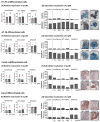Fibrates Affect Levels of Phosphorylated p38 in Intestinal Cells in a Differentiation-Dependent Manner
- PMID: 37175404
- PMCID: PMC10178720
- DOI: 10.3390/ijms24097695
Fibrates Affect Levels of Phosphorylated p38 in Intestinal Cells in a Differentiation-Dependent Manner
Abstract
Fibrates are widely used hypolipidaemic agents that act as ligands of the peroxisome proliferator-activated receptor α (PPARα). p38 is a protein kinase that is mainly activated by environmental and genotoxic stress. We investigated the effect of the PPARα activators fenofibrate and WY-14643 and the PPARα inhibitor GW6471 on the levels of activated p38 (p-p38) in the colorectal cancer cell lines HT-29 and Caco2 in relation to their differentiation status. Fibrates increased p-p38 in undifferentiated HT-29 cells, whereas in other cases p-p38 expression was decreased. HT-29 cells showed p-p38 predominantly in the cytoplasm, whereas Caco2 cells showed higher nuclear positivity. The effect of fibrates may depend on the differentiation status of the cell, as differentiated HT-29 and undifferentiated Caco2 cells share similar characteristics in terms of villin, CYP2J2, and soluble epoxide hydrolase (sEH) expression. In human colorectal carcinoma, higher levels of p-p38 were detected in the cytoplasm, whereas in normal colonic surface epithelium, p-p38 showed nuclear positivity. The decrease in p-p38 positivity was associated with a decrease in sEH, consistent with in vitro results. In conclusion, fibrates affect the level of p-p38, but its exact role in the process of carcinogenesis remains unclear and further research is needed in this area.
Keywords: colorectal carcinoma; epoxyeicosatrienoic acids; fibrates; p38 MAPK; peroxisome proliferator-activated receptor α.
Conflict of interest statement
The authors declare no conflict of interest.
Figures



Similar articles
-
Peroxisome proliferator-activated receptor ɑ (PPARɑ)-cytochrome P450 epoxygenases-soluble epoxide hydrolase axis in ER + PR + HER2- breast cancer.Med Mol Morphol. 2020 Sep;53(3):141-148. doi: 10.1007/s00795-019-00240-7. Epub 2019 Dec 10. Med Mol Morphol. 2020. PMID: 31823010
-
Expression of cytochrome P450 epoxygenases and soluble epoxide hydrolase is regulated by hypolipidemic drugs in dose-dependent manner.Toxicol Appl Pharmacol. 2018 Sep 15;355:156-163. doi: 10.1016/j.taap.2018.06.025. Epub 2018 Jun 27. Toxicol Appl Pharmacol. 2018. PMID: 29960002
-
Soluble Epoxide Hydrolase as an Important Player in Intestinal Cell Differentiation.Cells Tissues Organs. 2020;209(4-6):177-188. doi: 10.1159/000512807. Epub 2021 Feb 15. Cells Tissues Organs. 2020. PMID: 33588415
-
Development of Fibrates as Important Scaffolds in Medicinal Chemistry.ChemMedChem. 2019 Jun 5;14(11):1051-1066. doi: 10.1002/cmdc.201900128. Epub 2019 May 7. ChemMedChem. 2019. PMID: 30957432 Review.
-
Selective peroxisome proliferator-activated receptor α modulators (SPPARMα): the next generation of peroxisome proliferator-activated receptor α-agonists.Cardiovasc Diabetol. 2013 May 31;12:82. doi: 10.1186/1475-2840-12-82. Cardiovasc Diabetol. 2013. PMID: 23721199 Free PMC article. Review.
Cited by
-
Mechanisms for fibrate lipid-lowering drugs in enhancing bladder cancer immunotherapy by inhibiting CD276 expression.BMC Cancer. 2025 Sep 1;25(1):1404. doi: 10.1186/s12885-025-14855-w. BMC Cancer. 2025. PMID: 40887616 Free PMC article.
-
Nuclear Receptors in Health and Diseases.Int J Mol Sci. 2023 May 23;24(11):9153. doi: 10.3390/ijms24119153. Int J Mol Sci. 2023. PMID: 37298107 Free PMC article.
References
-
- Tokuno A., Hirano T., Hayashi T., Mori Y., Yamamoto T., Nagashima M., Shiraishi Y., Ito Y., Adachi M. The effects of statin and fibrate on lowering small dense LDL- cholesterol in hyperlipidemic patients with type 2 diabetes. J. Atheroscler. Thromb. 2007;14:128–132. doi: 10.5551/jat.14.128. - DOI - PubMed
-
- Keech A., Simes R.J., Barter P., Best J., Scott R., Taskinen M.R., Forder P., Pillai A., Davis T., Glasziou P., et al. Effects of long-term fenofibrate therapy on cardiovascular events in 9795 people with type 2 diabetes mellitus (the FIELD study): Randomised controlled trial. Lancet. 2005;366:1849–1861. doi: 10.1016/S1567-5688(06)81349-8. - DOI - PubMed
MeSH terms
Substances
Grants and funding
LinkOut - more resources
Full Text Sources
Medical

